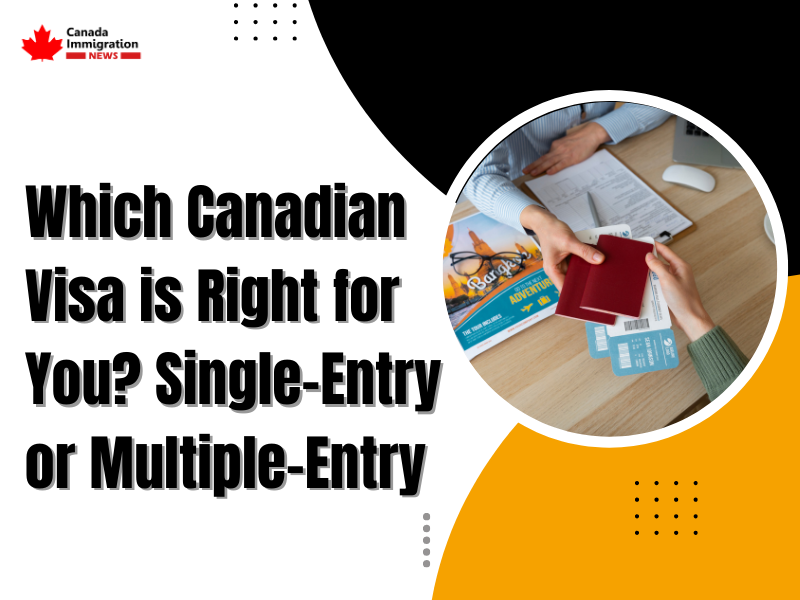By admin
Which Canadian Visa is Right for You? Single-Entry or Multiple-Entry
Choosing the right Canadian visa can feel confusing, especially when you’re deciding between a single-entry or multiple-entry option. Whether you’re planning a short visit or hoping to travel in and out of Canada frequently, understanding the difference between these visas is important.
Knowing which visa suits your needs can save you time, money, and unnecessary stress. In this blog, we will break down both single-entry and multiple-entry visas, so you can decide which Canadian visa is the best fit for your travel plans.
What is a Single-Entry Canadian Visa?
A single-entry Canadian visa allows you to enter Canada one time. Once you leave Canada, you can’t use the same visa to come back, even if it’s still valid. The only exception is if you travel to the United States, St. Pierre, or Miquelon. In that case, you may be allowed to re-enter Canada without needing a new visa, as long as your stay in those places was short.
A single-entry visa is typically issued for specific, short-term visits. For example, if you’re attending a conference, a wedding, or receiving medical treatment in Canada, a single-entry visa might be the right choice. It’s also common for first-time travelers to receive this type of visa, as Canadian immigration authorities might want to assess your travel history before granting a multiple-entry visa.
What is a Multiple-Entry Canadian Visa?
A multiple-entry Canadian visa lets you enter and leave Canada as many times as you want while the visa is valid. This type of visa can be valid for up to 10 years or until your passport expires. It’s perfect for travelers who need to visit Canada frequently, whether for business, family visits, or tourism.
With a multiple-entry visa, you can stay in Canada for up to 6 months at a time. If you need to stay longer, you can apply for an extension. The flexibility of this visa makes it a popular choice for people who travel often or want the option to return to Canada without reapplying for a visa every time.
Key Differences Between Single-Entry and Multiple-Entry Visas
To help you decide which Canadian visa is best for you, let’s break down the main differences:
| Aspect | Single-Entry Visa | Multiple-Entry Visa |
| Number of Entries | One entry only | Unlimited entries during visa validity |
| Duration of Stay | Set period, usually a few months | Up to 6 months per visit |
| Validity Period | Short-term, based on trip purpose | Up to 10 years or until passport expires |
| Travel to the U.S. | Can re-enter Canada from the U.S. in some cases | Can leave and return freely |
| Application Fee | Lower fee | Higher fee |
Which Canadian Visa Should You Choose?
The right visa depends on your travel needs. Here are some scenarios to help you decide:
1. Choose a Single-Entry Visa if:
- You plan to visit Canada once for a specific purpose (like a wedding or conference).
- You’re a first-time visitor and want to build a travel history.
- You won’t need to leave and re-enter Canada during your stay.
2. Choose a Multiple-Entry Visa if:
- You travel frequently for business or to visit family.
- You want the flexibility to enter and exit Canada without reapplying.
- You plan to make multiple short trips to Canada over several years.
How to Apply for a Canadian Visa
Whether you decide on a single-entry or multiple-entry visa, the application process is similar. Here’s what you need to do:
- Determine Your Visa Type: Decide whether a single-entry or multiple-entry Canadian visa suits your needs.
- Gather Required Documents: This usually includes a valid passport, recent photographs, proof of funds, travel itinerary, and a letter of invitation (if applicable).
- Complete the Application Form: Fill out the visa application form online through the Immigration, Refugees, and Citizenship Canada (IRCC) website.
- Pay the Application Fee: Fees vary depending on the type of visa. A single-entry visa costs less than a multiple-entry visa.
- Submit Biometrics: You may need to provide fingerprints and a photo at a visa application center.
- Wait for Processing: Visa processing times vary, so apply well before your planned travel date.
Deciding between a single-entry and multiple-entry Canadian visa doesn’t have to be difficult. It all comes down to how often you plan to travel to Canada and what suits your lifestyle best. If you only need to visit once, a single-entry visa might be the simplest and most cost-effective choice. But if you envision frequent trips or want the freedom to come and go, a multiple-entry visa is well worth the investment.
No matter which Canadian visa you choose, make sure to carefully prepare your application, provide all necessary documents, and apply early to avoid last-minute stress. With the right visa in hand, you’ll be ready to explore Canada, visit loved ones, or seize new opportunities.
